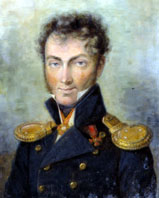Stepan Glotov facts for kids
Stepan Gavrilovich Glotov (born around 1729 in Yarensk, Russia – died May 5, 1769, on Unimak Island) was a Russian sailor, explorer, and fur trader. He was the first Russian captain to sail into the waters of the eastern Aleutian Islands. He also became the first European to discover Kodiak Island and several other islands in Alaska.
Contents
Early Journeys of Exploration
Stepan Glotov's first recorded journey was in 1746. He sailed on a ship called Ioann (meaning "John"). This ship belonged to a merchant named Fyodor Kholodilov. They sailed from the Kamchatka Peninsula to hunt for sea otters and seals. They spent the winter on Bering Island. The next spring, the Ioann tried to find the middle Aleutian Islands, but they were not successful.
From 1758 to 1762, Glotov and some Cossacks explored on a ship named Saint Julian. This journey helped open up the Aleutian Islands for the Russian fur trade.
The Saint Julian left the Kamchatka River on September 2, 1758. After nine days, Glotov reached the Commander Islands. They spent the winter on Medny Island. Then, Glotov's group sailed east and found Umnak Island in the Aleutians. They landed there on September 1, 1759. The native Aleuts immediately attacked them. Glotov was hurt, and two of his men were killed. However, Glotov chose to be calm and not fight back too much at that time.
Glotov and his men stayed on Umnak for three winters. They collected over a thousand fox furs and many sea otter skins. Glotov was the first to bring large amounts of fox fur back to Russia from Alaska. During this time (1759–1762), Glotov and his men also discovered other islands in the Aleutian chain, including Unimak and Unalaska.
The Saint Julian returned to Kamchatka on August 31, 1762. In his report, Glotov listed 29 islands and described the animals living on them.
1762 Expedition and Conflict with Natives
On October 1, 1762, Glotov started another expedition. He sailed from Kamchatka to the Aleutian Islands and the northwestern coast of North America. He was on a ship called Adrian and Natalia. Glotov had a crew of 38 Russians and eight Kamchadals (native people from Kamchatka). Glotov and his men again spent the winter on Medny Island. They left there on July 26, 1763. Glotov discovered several more islands, including Kodiak Island. Kodiak Island is one of the largest islands in the world.
During this journey, Glotov and his men faced a revolt by the Aleut natives of the Fox Islands. The Aleuts were unhappy because of the actions of Russian fur workers, called Promyshlenniki. These workers were often harsh and greedy. They forced native people to work and pay a tax called Yasak. This tax was paid in furs. Sometimes, the fur workers would take families hostage to make sure the tax was paid.
Because of this, the Aleuts fought back against the Russian presence. They killed many Russians and drove most of the others away from the islands. They also destroyed most of the Russian ships in the area.
Glotov and his men destroyed Aleut villages on the southern part of Umnak. With help from other groups, the revolt ended. Many Aleuts were killed directly, and many more died from related problems like wounds, hunger, cold, and sickness. This event effectively ended the Aleutian people's independence.
During this expedition, Glotov also gathered important information about the Aleuts' culture and way of life.
Last Journey and Death
In October 1768, Glotov was part of another expedition. This group explored about 200 kilometers (124 miles) of the northern coast of the Alaska Peninsula. They also discovered Port Moller Bay.
Stepan Glotov died in the spring of 1769. He passed away from scurvy while spending the winter on Unimak Island. Scurvy is a disease caused by not getting enough vitamin C.
A mountain on Kodiak Island is named after Glotov. There is also a street named for him in the village of Yarensk.
In 1992, archaeologists found the place on Unangan where Glotov was attacked by armed native people.
Images for kids



